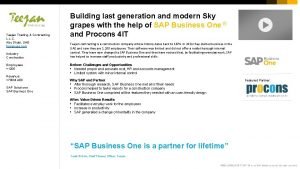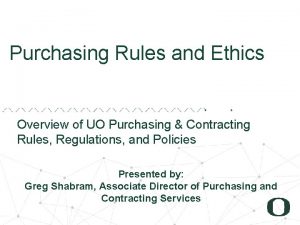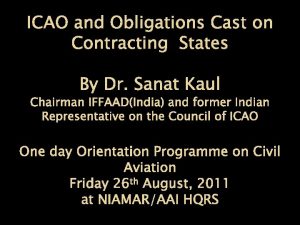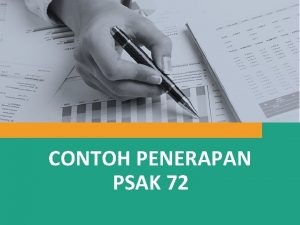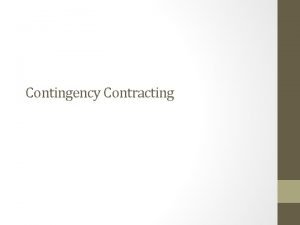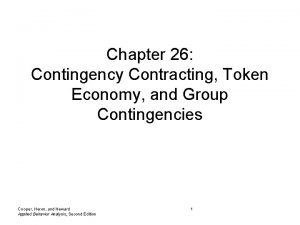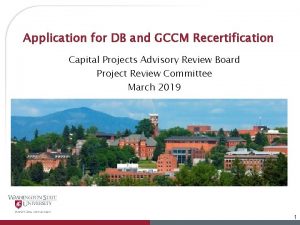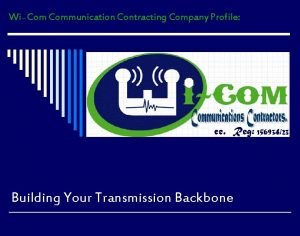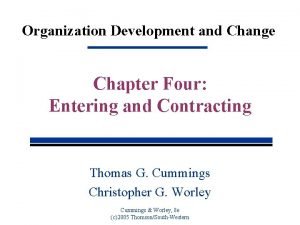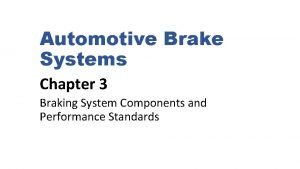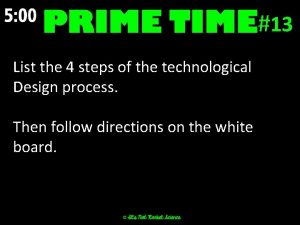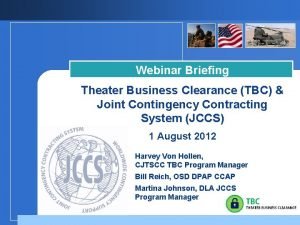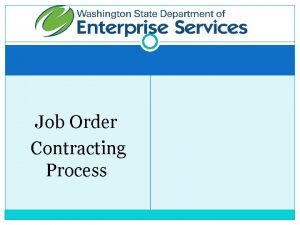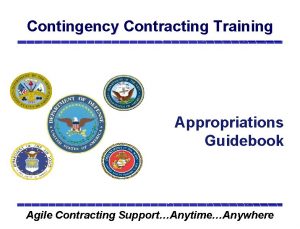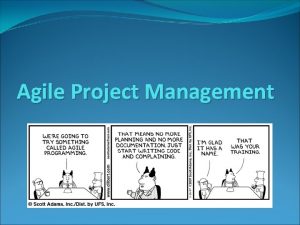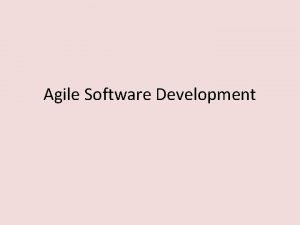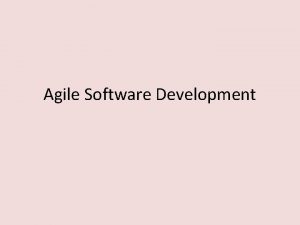Agile Contracting for Results The Next Level of


























- Slides: 26

Agile Contracting for Results: The Next Level of Agile Project Management 10: 15 to 11 session, 4 th 10 minute talk Monday 27 Oct 2014 Smidig Conference 2014 Oslo Tom@Gilb. com WWW. Gilb. com 01 March 2021 Tom@Gilb. com 1

Mobius Loop Continuous exploration of results can be contractually managed 01 March 2021 Tom@Gilb. com 2

The Mobius Loop Template Plan Do Study Act for Agile 01 March 2021 Tom@Gilb. com 3

Issues caused by traditional contracts (go quickly to next slide) • KNOWLEDGE GAP - Specifying too much detail in the contract creates uncertainty • ALIGNMENT GAP - Using a contract to regulate at a micro level the activities of a project is dysfunctional • ALIGNMENT / EFFECTS GAP - The contract fails to respond adequately to change: • Members of the team are not empowered to use their own initiative • Change control requests are time-consuming, expensive and add no real value • Change control requests can destabilise the project and can lead to a ‘Frankenbuild’ 01 March 2021 Tom@Gilb. com 4

The effect of friction (why results are so uncertain) 01 March 2021 Tom@Gilb. com 5

Problems with Contracts with shorter development paths • Typically the solution is decomposed into a series of ‘minimum viable products’ or the equivalent • Pros: Customer insight into the development process Mirrors current procurement models Appears to facilitate the management of budgets and schedules • Cons: – – The solution will not necessarily meet the customer's expectations Risk of amateurish design by the customer Supplier is incentivised to create more features 01 March 2021 Tom@Gilb. com 6

Problems with Velocity-based contracts • Typically the supplier commits to provide a certain number of ‘units of work’ which may comprise story points or function points over a set period of time • Pros: Increased flexibility Easy to measure • Cons: The solution will not necessarily meet the customer's expectations An emphasis on velocity is no guarantee of quality The supplier is incentivised to create more output 01 March 2021 Tom@Gilb. com 7

Problems with ‘Agile methodology’ contracts • The contract documents the Agile development process • Pros: More accurately reflects the ‘Agile process’ • Cons: Typically the Agile process changes over the course of the project Inconsistent with the principles of Agile which are ‘resultsfocused’ The supplier is incentivised to create more activities The solution will not necessarily meet the customer's expectations 01 March 2021 Tom@Gilb. com 8

Traditional view of contract metrics (The code stuff and ‘pray’ method) 01 March 2021 Tom@Gilb. com 9

Agile code stuff and pray 01 March 2021 Tom@Gilb. com 10

Outcome-driven view of contract metrics: If you didn’t really deliver value, try again 01 March 2021 Tom@Gilb. com 11

An introduction to empirical management: Hope to get good value, but if not; TRY DIFFERENT 01 March 2021 Tom@Gilb. com 12

An overview of the Flexible Contract (part 1) www. flexiblecontracts. com • Modular delivery – To increase contractual flexibility. • Outcome-based delivery - The supplier is free to develop the optimum solution within the constraints to deliver the target outcomes which will achieve the business objectives: • Business objectives– The opportunity(s) to address and/or the problem(s) to solve and how they will deliver tangible value to the customer. • Target outcomes – The business results aligned with the business objectives that the customer wishes to pursue. These must be objective and either quantified or qualified. • Constraints – The constraints outside of which the solution must not deviate. • Options – Potential solutions which facilitate measurable progress towards the target outcomes. 01 March 2021 Tom@Gilb. com 13

An overview of the Flexible Contract (part 2) www. flexiblecontracts. com • Outcome-based metrics – Any potential solution must be measured against the target outcomes. • Outcome-based fees – At least part of the fees should be payable on the achievement of target outcomes. • No contractual sanction if the outcome-based metrics are not achieved – – It is an empirical process to explore whether the target outcomes are achievable, – and when enough has been done to achieve them. 01 March 2021 Tom@Gilb. com 14

Pros and cons of the Flexible Contract • Pros: – A structured approach for focusing on the customer’s strategic plan – The creation of shared goals helps to align the interests and motivation of the parties – The supplier is motivated to achieve the target outcomes in the most cost-effective way – Outcomes are less susceptible to change, than output – The parties can learn rapidly what works and what doesn’t by measuring progressively the outcome delivery • Cons: – Lack of familiarity – Outcomes are not as straightforward as other contract metrics and require some training 01 March 2021 Tom@Gilb. com 15

The Flexible Contract is more tuned in to agile 01 March 2021 Tom@Gilb. com 16

Contract Templates available for free (Norwegian tuning needed) 01 March 2021 Tom@Gilb. com 17

WHAT IS A FLEXIBLE CONTRACT? These details are in the contract template WHAT IS A FLEXIBLE CONTRACT? A ‘flexible contract’ is an adaptive, outcome-based contract, which is intended to maximize the delivery of customer value. It achieves this in several ways: The contract focuses on outcomes (that is, business objectives), which are less susceptible to change than output (such as features). By focusing on outcomes the contract also creates shared goals between the customer and supplier, which helps to align their interests and motivation. The supplier is given the freedom to achieve the target outcomes in any way it deems effective as long as it honors the terms of the contract and stays within any constraints specified by the customer. The fees (or at least part of the fees) should be payable on the achievement of target outcomes. The supplier is incentivized to achieve the target outcomes in the most cost-effective way, which is also of benefit to the customer. The contract is structured as a master services agreement for the full version, or the ‘lite’ version using the Terms and Conditions, under which short-term statements of target outcomes (SOTOs) are called off. SOTOs work in the same way as a Statement of Work, but instead of ‘work’ in the form of outputs and activities, we measure outcomes achieved. The parties can respond to acquired knowledge and changes in the environment in subsequent SOTOs. In respect of each SOTO the supplier addresses each target outcome by means of short feedback cycles. So the parties can learn rapidly what works and what doesn’t by measuring outcomes achieved progressively. The contract adopts lightweight contractual provisions. This is made possible because the parties only commit to one SOTO at a time, so the financial exposure of the customer to the supplier is minimized. This in turn means that the contract is easier to understand requires less administrative cost, both to create and to manage. The contract is deliberately NOT focused on the activities of the supplier or the technical processes by which this value is delivered. 01 March 2021 Tom@Gilb. com 18

WHAT IS A FLEXIBLE CONTRACT? Define what you want, as you go, in small increments. WHAT IS A FLEXIBLE CONTRACT? A ‘flexible contract’ is an adaptive, outcome-based contract, which is intended to maximize the delivery of customer value. It achieves this in several ways: The contract focuses on outcomes (that is, business objectives), which are less susceptible to change than output (such as features). By focusing on outcomes the contract also creates shared goals between the customer and supplier, which helps to align their interests and motivation. The supplier is given the freedom to achieve the target outcomes in any way it deems effective as long as it honors the terms of the contract and stays within any constraints specified by the customer. The fees (or at least part of the fees) should be payable on the achievement of target outcomes. The supplier is incentivized to achieve the target outcomes in the most cost-effective way, which is also of benefit to the customer. The contract is structured as a master services agreement for the full version, or the ‘lite’ version using the Terms and Conditions, under which short-term statements of target outcomes (SOTOs) are called off. SOTOs work in the same way as a Statement of Work, but instead of ‘work’ in the form of outputs and activities, we measure outcomes achieved. The parties can respond to acquired knowledge and changes in the environment in subsequent SOTOs. In respect of each SOTO the supplier addresses each target outcome by means of short feedback cycles. So the parties can learn rapidly what works and what doesn’t by measuring outcomes achieved progressively. Learn what works Focus on business results, not ‘code’ Pay for real value delivered Prioritize high value results early. The contract adopts lightweight contractual provisions. This is made possible because the parties only commit to one SOTO at a time, so the financial exposure of the customer to the supplier is minimized. This in turn means that the contract is easier to understand requires less administrative cost, both to create and to manage. The contract is deliberately NOT focused on the activities of the supplier or the technical processes by which this value is delivered. Very low risk 01 March 2021 Not tied in to suppliers who cannot deliver Tom@Gilb. com 19

SOTO Specification (from contract template) short-term Statements Of Target Outcomes 01 March 2021 Tom@Gilb. com 20

(from contract template) 01 March 2021 Tom@Gilb. com 21

Credits for most slides to • www. flexiblecontracts. com • https: //www. linkedin. com/groups/Flexible. Agile-contracts-7460556/about • www. mobiusmodel. org • I have been working together with Susan Atkinson and Gabrielle Benefield for several years regarding these ideas. So it is no surprise that they are very complimentary to the Evo and Planguage methods in my writings, such as Competitive Engineering (2005), and Value Planning (2014, manus) • • Forthcoming Book 01 March 2021 Tom@Gilb. com 22

Mobius Loop 01 March 2021 Tom@Gilb. com 23

Mobius mobiusloop. com/#mobius • • 01 March 2021 Tom@Gilb. com PREVIEW - MOBIUS THE BOOK We are currently writing a book on delivering better outcomes with Mobius. Along the way we are releasing chapters and encouraging feedback and contributions from our community. As of May 25, 2014 the book contains the following chapters, click any to download: CHAPTER 1 - READER'S GUIDE CHAPTER 2 - OUTCOMES OVER OUTPUTS CHAPTER 3 PROBLEMS AND OPPORTUNITIES CHAPTER 4 OUTCOMES CHAPTER 5 - DEEP DIVE (EARLY DRAFT) CHAPTER 6 OPTIONS 24

Practical Tools for Value Quantification • Free digital copy of CE on request – From Tom@Gilb. com • New book manuscript on ‘value outcome specification’ – tinyurl. com/valueplanning • Agile Contracting for Results – Paper in Agile Record – www. gilb. com//dl 581 01 March 2021 Tom@Gilb. com 25

Last slide 01 March 2021 Tom@Gilb. com 26
 X.next = x.next.next
X.next = x.next.next Next level innovations
Next level innovations Swot analysis of event venue
Swot analysis of event venue Next level building
Next level building Teejan trading & contracting
Teejan trading & contracting Uo purchasing and contracting
Uo purchasing and contracting Contract management framework
Contract management framework Each contracting state may
Each contracting state may Nrcg contracting for fire
Nrcg contracting for fire Ctip clause that must be included in every contract
Ctip clause that must be included in every contract Imbalan variabel adalah
Imbalan variabel adalah Contingency contracting definition
Contingency contracting definition Universal fencing contracting
Universal fencing contracting Contingency contract aba
Contingency contract aba Contracting authority
Contracting authority Brute contracting
Brute contracting Huff contracting
Huff contracting Contracting company
Contracting company 360 contracting
360 contracting External contracting brakes
External contracting brakes Italy population pyramid
Italy population pyramid Interpersonal process issues in entering and contracting
Interpersonal process issues in entering and contracting Exblowra trading and contracting
Exblowra trading and contracting Main components of the braking system
Main components of the braking system What macromolecule is used for contracting muscles? *
What macromolecule is used for contracting muscles? * Tec login
Tec login Job order contracting guide army
Job order contracting guide army




